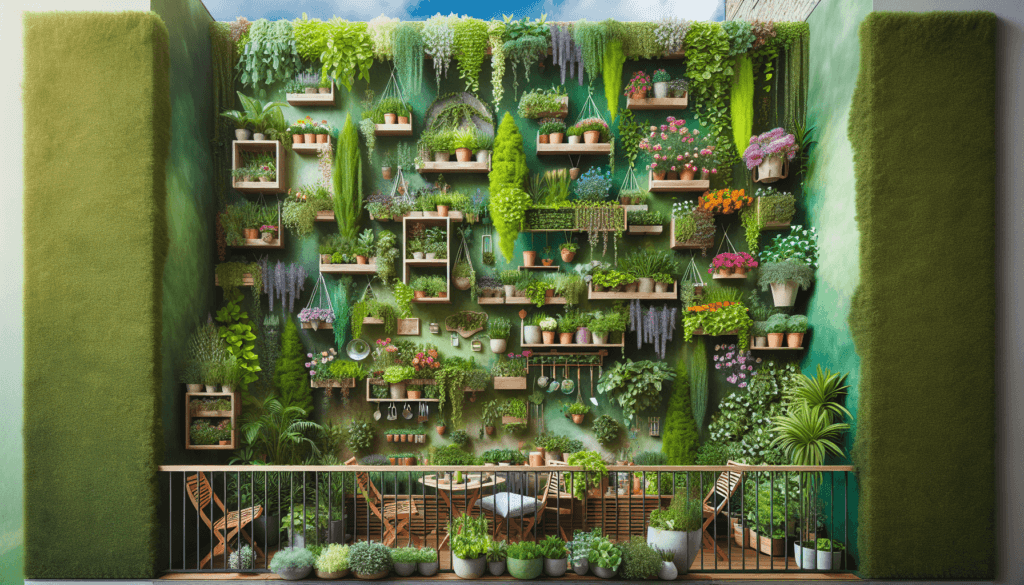Have you ever dreamed of having a lush garden but felt limited by the size of your space? Look no further! In this article, we will show you how to create a DIY vertical garden specifically designed for small spaces. You don’t need a large backyard or a green thumb – with just a few simple steps, you can transform any small area into a vibrant and flourishing garden. Say goodbye to cramped living quarters and hello to a green oasis right at home. Get ready to unleash your inner gardener and bring nature indoors!
Choosing the Right Location
Consider the amount of sunlight
When choosing a location for your DIY vertical garden, it’s important to consider the amount of sunlight that area receives. Most plants require a certain amount of sunlight to thrive, so assess the site for its exposure to direct or indirect sunlight. Take note of any potential obstructions such as buildings or trees that may cast shadows and affect the amount of sunlight the garden will receive throughout the day.
Assess the available space
The available space will also play a significant role in determining the size and design of your vertical garden. Evaluate the dimensions of the area and consider factors such as height and width. It’s important to choose a space that can accommodate the structure and plants without overwhelming the area or obstructing pathways.
Check for accessibility
Accessibility is another crucial aspect to consider when selecting the location for your vertical garden. Ensure that the site allows for easy access for watering, maintenance, and harvesting. If the garden is too difficult to reach or maintain, it may deter you from caring for your plants properly, leading to poor growth and health. Choose a location that is convenient and easily accessible to make gardening a joy rather than a chore.
Selecting the Right Plants
Choose plants suitable for vertical gardening
When it comes to vertical gardening, it’s important to choose plants that are suitable for this type of structure. Look for plants that are known to grow well in confined spaces, have shallow root systems, or have natural tendencies to climb or trail. Popular choices for vertical gardens include herbs, succulents, strawberries, and certain types of vegetables like lettuce or spinach. Research different species to find ones that will thrive and complement each other in your garden.
Consider the needs of the plants
Different plants have different needs when it comes to sunlight, water, and nutrients. Consider the specific requirements of the plants you have chosen and ensure that they match the conditions of your chosen location. Some plants may thrive in full sun, while others prefer partial shade. Take into account the climate in your region and choose plants that will adapt well to the conditions.
Mix and match different types of plants
To create an interesting and visually appealing vertical garden, it’s a good idea to mix and match different types of plants. Combine plants with various textures, colors, and growth habits to create a dynamic and vibrant display. You can also consider incorporating both edible and ornamental plants to maximize the functionality and beauty of your vertical garden. Experiment with different combinations to find the perfect balance and create a truly unique garden.

Preparing the Vertical Garden Structure
Decide on the type of structure
Before building your vertical garden, it’s essential to decide on the type of structure you want to use. There are various options available, such as a trellis, pallets, grid systems, or even repurposed materials like shoe organizers or gutters. Consider the style, budget, and complexity of the structure, ensuring that it suits both your gardening needs and the aesthetic of the space in which it will be placed.
Measure and mark the desired dimensions
Once you have decided on the structure, measure and mark the desired dimensions of your vertical garden. This will help you accurately plan and construct the structure and ensure that it fits seamlessly into your chosen location. Take into account the width, height, and depth of the structure, considering the available space and the number of plants you wish to accommodate.
Prepare the necessary tools and materials
Before starting the construction of your vertical garden, gather all the necessary tools and materials. This may include a drill, screws, brackets, levels, measuring tape, and wood or metal for the structure. Ensure that you have everything you need on hand to avoid interruptions during the building process. Additionally, consider using materials that are durable and weather-resistant to ensure the longevity of your vertical garden.
Building the Vertical Garden
Start with the base structure
Once you have all the tools and materials ready, start building your vertical garden by constructing the base structure. This is the foundation upon which the rest of the garden will be built, so it’s important to ensure its stability and strength. Follow the instructions or plans for your chosen structure, making sure to secure all connections and joints properly.
Secure the structure to the wall or support
To ensure the stability and safety of your vertical garden, it’s crucial to secure the structure to a wall or support. Use screws, brackets, or other appropriate fasteners to attach the structure securely. Depending on the weight and size of the structure, it may be necessary to use anchors or additional reinforcement for added stability. Always follow the manufacturer’s instructions and recommendations for securing the structure to avoid accidents or damage.
Add additional layers and shelves
Once the base structure is secure, you can start adding additional layers and shelves to your vertical garden. This will allow you to maximize the space and accommodate more plants. When adding layers, make sure they are evenly spaced and securely attached to the structure. Consider the weight-bearing capacity of each layer and ensure that it can support the weight of both the plants and the growing medium.

Creating Drainage and Irrigation
Drill holes for drainage
Proper drainage is essential for the health of your vertical garden. Without adequate drainage, excess water can accumulate in the structure, leading to root rot and other moisture-related issues. Drill small drainage holes in each layer and shelving unit to allow excess water to flow out freely. Ensure that the holes are evenly spaced and large enough to promote effective drainage without compromising the structural integrity of the garden.
Install an irrigation system
To simplify the watering process and ensure that your plants receive adequate moisture, consider installing an irrigation system. This can be as simple as a drip system with tubing and emitters or a more sophisticated setup with timers and sensors. An irrigation system not only saves time and effort but also helps maintain consistent moisture levels and prevents overwatering or underwatering.
Consider using a reservoir system
For added convenience and water efficiency, you may want to consider incorporating a reservoir system into your vertical garden. A reservoir system collects and recirculates excess water, reducing the need for frequent watering. By storing the water in a reservoir at the base of the structure, it can be recycled and reused by the plants as needed. This is particularly beneficial for vertical gardens in dry or arid climates.
Planting and Arranging the Plants
Prepare the soil or growing medium
Once your vertical garden structure is complete, it’s time to prepare the soil or growing medium. Choose a high-quality potting mix or create a custom growing medium suitable for the plants you have selected. Ensure that the soil or medium is well-draining, lightweight, and rich in nutrients to promote healthy growth. Fill each layer and shelf with the prepared soil, leaving enough space for the roots of the plants.
Carefully transplant or sow the plants
When planting in a vertical garden, it’s essential to be gentle and careful to avoid damaging the plants. If you are transplanting, gently loosen the roots and place the plants into their designated spaces. If you are sowing seeds directly, follow the instructions for seed depth and spacing. Pay attention to the specific requirements of each plant and ensure that they are placed at the appropriate height and distance to allow for optimal growth and development.
Arrange the plants strategically
To create a visually appealing vertical garden, strategically arrange the plants based on their growth habits, sizes, and colors. Place taller or climbing plants towards the back or center of each layer, allowing them to grow upwards and utilize the vertical space. Use trailing or cascading plants towards the edges or front of the structure to create a lush and vibrant display. Experiment with different arrangements and consider the overall aesthetic you wish to achieve.

Providing Adequate Support
Install stakes or trellises for climbing plants
For climbing plants, it’s important to provide adequate support to ensure their upward growth. Install stakes or trellises along the back or center of the layers where the climbing plants are placed. This will allow the plants to attach themselves and grow vertically, preventing them from sprawling or trailing in unwanted directions. Regularly check the supports and adjust them as needed to accommodate the growth of the plants.
Use plant ties or supports for bushier plants
Bushier plants may require additional support to maintain their shape and prevent them from drooping or overcrowding nearby plants. Use plant ties or supports to gently secure and guide the branches or stems of these plants. This will help maintain an organized and visually pleasing appearance while allowing adequate space and light for the surrounding plants. Adjust the ties or supports as the plants grow to prevent any damage or restriction.
Regularly check and adjust the supports
As your vertical garden grows and develops, it’s important to regularly check and adjust the supports. This ensures that the plants have the necessary assistance and prevents any potential damage caused by overgrowth or overcrowding. Take note of any signs of stress or strain on the supports and make adjustments accordingly. Regular maintenance and monitoring of the supports will help maintain the structural integrity and aesthetic appeal of your vertical garden.
Maintaining the Vertical Garden
Water the plants regularly
Proper watering is crucial for the health and growth of your vertical garden. Depending on the plants and the environment, observe the moisture level of the soil or growing medium and water as needed. Avoid overwatering, which can lead to root rot, and underwatering, which can cause wilting and stunted growth. Consider using a moisture meter or simply monitoring the weight and appearance of the plants to determine when it’s time to water.
Monitor for pests and diseases
Regularly monitor your vertical garden for any signs of pests or diseases. Inspect the plants carefully, paying attention to any discoloration, wilting, or unusual growth patterns. Common pests such as aphids, mealybugs, or spider mites can quickly infest your garden and cause damage if left unchecked. Treat any issues promptly using organic or appropriate pest control methods to prevent the spread and ensure the health of your plants.
Trim and prune as needed
To maintain the shape and vitality of your vertical garden, it’s important to regularly trim and prune the plants. Remove any dead or yellowing leaves, damaged branches, or excessive growth to promote airflow and prevent overcrowding. This will also help redirect the plant’s energy towards healthy growth and encourage the development of new foliage. Use clean and sharp pruning tools to avoid spreading diseases and ensure clean cuts.

Enhancing the Vertical Garden
Add decorative elements
To enhance the visual appeal of your vertical garden, consider adding decorative elements. Incorporate colorful pots or containers, decorative stones or pebbles, or even small statues or ornaments that match the style of your garden. These decorative elements can add a personal touch and make your vertical garden a true reflection of your taste and personality.
Incorporate hanging planters or containers
In addition to the plants grown within the structure, consider incorporating hanging planters or containers into your vertical garden. This will allow you to expand your planting opportunities and add more variety to the display. Hang the planters at different heights throughout the garden, creating an eye-catching arrangement. Choose plants that complement the ones within the structure to create a harmonious and cohesive overall look.
Install lighting for a visually appealing display
To highlight the beauty of your vertical garden, install lighting that illuminates the structure during the evening or at night. Choose LED or solar-powered lights that are energy-efficient and weather-resistant. Strategically place the lights to highlight the plants and create a captivating ambiance. This will not only extend the enjoyment of your vertical garden into the evening but also create a visually appealing display for all to admire.
Troubleshooting Common Issues
Addressing waterlogging or poor drainage
If you notice waterlogging or poor drainage in your vertical garden, it’s important to address the issue promptly to prevent damage to the plants. Check if the drainage holes are clear and unclogged, and adjust the angle of the structure if necessary to promote better water flow. Consider adding a layer of coarse gravel at the bottom of each shelf or layer to improve drainage. If the problem persists, consider redesigning or modifying the structure to better accommodate drainage.
Dealing with pests and diseases
Pests and diseases can pose a threat to the health of your vertical garden. If you encounter these issues, it’s important to take immediate action to prevent further damage. Avoid using chemical pesticides that may harm beneficial insects or pollinators and opt for organic or natural methods instead. Introduce predatory insects, use insecticidal soaps, or create homemade remedies using ingredients like neem oil or garlic. Regularly monitor and inspect your plants to catch any infestations or diseases early.
Solving plant overcrowding
When plants in your vertical garden become overcrowded, they can compete for resources and impede each other’s growth. Regularly thin out or relocate plants that are encroaching on others or not thriving. This will promote healthier growth and prevent the garden from becoming overcrowded and visually cluttered. If necessary, replant or relocate the excess plants to another suitable area or share them with fellow garden enthusiasts.
Creating a DIY vertical garden for your small space can be a rewarding and enjoyable project. By carefully considering the location, selecting the right plants, and preparing and building the structure, you can create a vibrant and functional garden that maximizes your limited space. Remember to provide adequate support, maintain the garden regularly, and enhance its appeal with decorative elements and lighting. With proper care and attention, your vertical garden will thrive and bring joy to your surroundings.



